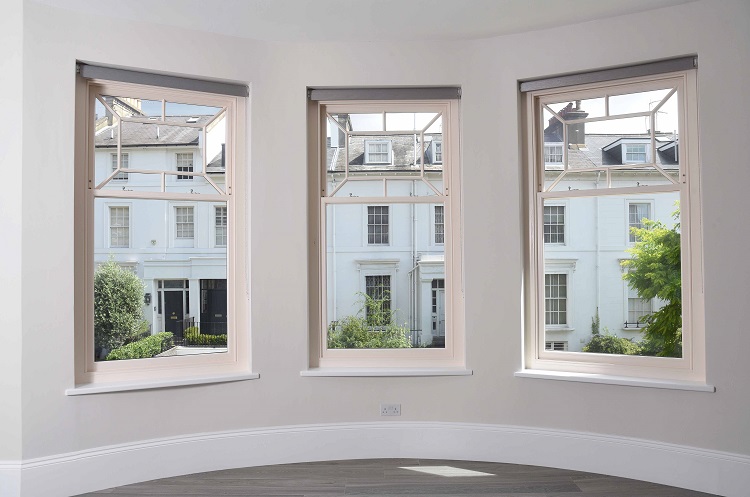If you live in an older home with original wood sash windows, you may be dealing with drafts, sticking, peeling paint, and high energy bills. Replacing old, inefficient sash windows with new energy efficient models can make a huge difference in home comfort and energy savings. Keep reading to learn all about sash window styles, energy efficient options, and the benefits of upgrading your windows during your next home renovation.
Table of Contents
Common Sash Window Styles
Sash windows are any windows where the glass pane is surrounded by movable glazed frames or “sashes” that slide up and down within the window frame. Most older homes have double hung sash windows with an upper and lower sash that both slide open. Other styles include single hung with only a moving lower sash, horizontal sliding sashes, and casement windows that open via hinges on one side.
No matter the style, traditional wood sash windows can loosen and warp over time, resulting in major air leaks and higher energy bills. If your sash windows are more than 20 years old, an upgrade to newer vinyl, fiberglass or composite window materials can save significant money on heating and cooling costs going forward.
Energy Efficient Replacement Options
When shopping for sash window replacements, look for options that are Energy Star certified. This means they meet strict energy performance guidelines set by the EPA that will reduce home energy use. Some key features to look for include:
- Multi-pane glass with argon gas fill in air space between panes
- Insulated frames made of vinyl, composite materials, or fiberglass
- Weatherstripping around movable sash components
- High performance glazing treatments like low-emissivity coatings to reflect heat
- Structural enhancements like double strength glass, reinforced locking hardware
- Thermally broken frame components to resist conduction
Upgraded glass technologies are extremely effective for boosting window energy efficiency. Opting for triple pane glass versus standard double pane can further slash U-Factors (rate of heat loss) and solar heat gain while blocking more noise. Low-E coatings are practically invisible, but block heat driven through glass via radiation. And inert argon gas pumped between panes cuts down on conductive and convective heat flow.
Together, these advancements enable replacement windows to meet a very low U-Factor around 0.27-0.30 and potentially qualify for an ER rating – the highest efficiency classification for windows.
Custom Options for Historical Authenticity
If you live in a historical home, upgraded windows are still possible without sacrificing architectural accuracy. Many manufacturers offer custom sash window solutions made of engineered materials or solid wood frames coupled with reproduction muntins, true divided lies, and interior wooden sash components. Exterior elements can match traditional aesthetics while interior enhancements are hidden.
Historical accuracy ordinances do not have to prevent homeowners from accessing energy savings through proper window upgrades. Consult local regulations and manufacturers’ custom shops to explore your options first.
Hiring a Professional
Tackling a full sash window replacement project for an entire home can be complicated. First windows must be properly measured and assessed to specify the right product replacements. Then the physical installation typically involves structural modifications to remove old window units and install new ones securely.
Seeking out professional installation is highly recommended to get safe, effective results as well as manufacturer warranties on window products and workmanship. DIY installations are prone to air leaks, insulation issues, and improper structuring that forfeits guarantees. Industry associations like the American Window and Door Institute can connect you with certified specialists in your local area.
Return on Investment
Upgrade costs for sash window replacements run approximately $600-1,200 per window opening depending on materials, custom options, accessory enhancements, structural modifications required, labor costs and your geographic area. Adding special glass technologies or custom-built options for historical homes increases per unit expenditures accordingly.
Luckily most replacement projects break even rather quickly in 5-7 years and then start saving money in the long-term. Document your existing window inefficiencies first via home energy audits. Then after installing upgrades, compare efficiency performance through changes in energy bills. Any reduction in heating/cooling expenses after installations are direct savings derived from enhanced window energy performance.
Additional upgrades like wall insulation, air sealing, heating system upgrades simultaneously with new windows can further cut home energy costs for even faster ROI. Taking advantage of rebates, tax credits and seasonal installation discounts also assure a better return on investment timeline for sash window replacement projects.
Benefits of Sash Window Upgrades
If drafty windows are plaguing your older home, sash window upgrades merit consideration for ease, aesthetics, and energy efficiency. Key benefits such upgrades can deliver include:
- Greater Home Comfort – eliminate drafts through improved weatherproofing, tighter air seals, moderate indoor temps better
- Noise Reduction – multi-pane windows better insulate against outside noise intrusions
- UV Protection – advanced glazing filters out sun’s harshest rays protecting interiors & occupants
- Lower Energy Bills – reduced air leaks, improved insulation, modern components cut heating/cooling costs
- Added Home Value – desirable energy upgrades can boost appraisal values & accelerate sales
- Visual Appeal – new construction allows correcting flaws, custom matching home’s historical style
- Minimal Maintenance – modern materials require less upkeep than older single pane windows
- Safety & Security Features – laminated glass, reinforced frames withstand zone impacts & forced entries
Final Words
Over time sash window upgrades make homes more enjoyable places to live while ensuring major energy bill savings year after year. Initiating full-home window replacements immediately or staggering projects over coming years makes transformation affordable. Consult local window experts to evaluate your best replacement options and start reaping the many short and long-term rewards these accessible upgrades can bring.










